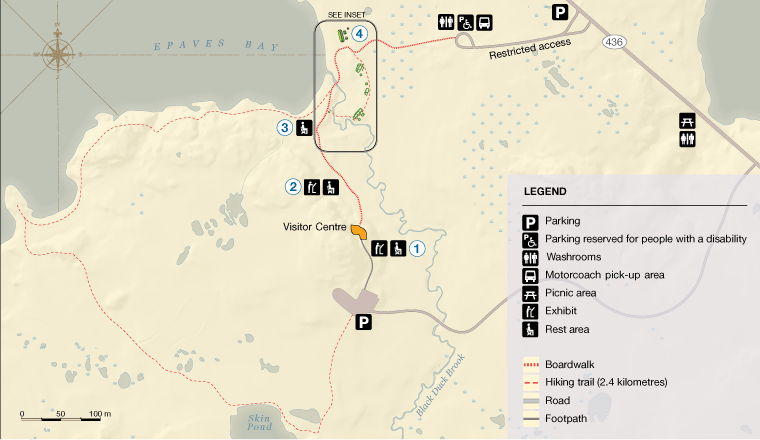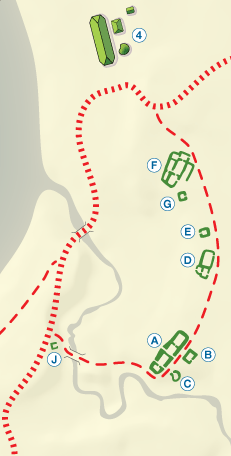Maps and brochures
L'Anse aux Meadows National Historic Site

© Parks Canada

© Parks Canada
Interpretive Areas
1. UNESCO World Heritage plaque, Historic Sites and Monuments Board of Canada
plaque, Ingstad bust
2. Meeting of Two Worlds
sculpture
3. Aboriginal campsites
4. Reconstructed buildings
Remains of Norse Buildings
A. This large hall was built for someone of high social status. It contains a small private room and communal living and working quarters for the rest of the crew. One of the rooms was littered with slag, and may have been used for iron working. Jasper chips from fire-starters show that the crew came from Iceland.
B. House—lower-status living quarters and a place for roasting bog ore before smelting.
C. Hut—lowest-status housing at this site, serving perhaps as quarters for several slaves.
D. The smallest of the three halls, probably built for a crew of labourers. Judging by the jasper chips aroudn the fire, they were from Iceland. This hall contains a large storeroom, possibly for furs and perishable items. Another room was littered with woodworking debris, both inside and out.
E. Hut—probably used by women as a workshop, and perhaps as living quarters. Stone weights inside may have been part of a loom.
F. Leader’s hall—This is the largest building, twice the size of Eirik the Red’s home in Greenland, and equivalent in size to a chieftain’s hall in Iceland. The leader of the expedition probably lived in this hall with his crew. Jasper chips show that its inhabitants came from Greenland. It contained a private room for the leaders, a large central room that could serve as a banquet hall, two large storage rooms, and a lean-to shed for boat repair.
G. Hut—workshop and living space for lower-status crew.
J. Smelting hut—this small isolated building contained a furnace for producing iron from bog ore. A simple smelter stood in the middle of the floor. A charcoal kiln was nearby. The amount and type of slag found suggests that a single smelt took place. Very little iron was manufactured, only enough for making about 100 to 200 nails.
Related links
- Date modified :